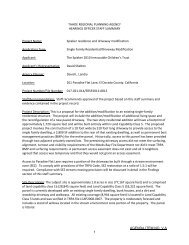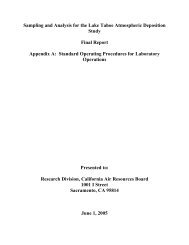FEIS - Tahoe Regional Planning Agency
FEIS - Tahoe Regional Planning Agency
FEIS - Tahoe Regional Planning Agency
You also want an ePaper? Increase the reach of your titles
YUMPU automatically turns print PDFs into web optimized ePapers that Google loves.
RESPONSE TO COMMENTS ON THE DEIS<br />
B o u l d e r B a y C o m m u n i t y E n h a n c e m e n t P r o g r a m P r o j e c t E I S<br />
Comment 335-k: Comment Summary - The EIS needs to provide evidence that Alts. C and D, and CEP<br />
projects provide a substantial net water quality benefits. Post-project monitoring is<br />
not considered adequate.<br />
Impact HYDRO-1 is addressed on page 4.2-32 of the DEIS. Post-project monitoring<br />
will be completed to further calibrate predictive models and substantiate assumed<br />
effectiveness of the proposed stormwater treatment systems, BMPs and LID<br />
strategies. The supplemental analysis in Appendix AB for further quantification of<br />
the water quality benefits.<br />
Comment 335-l: Comment Summary - The HYDRO-1 mitigation: the security deposit fee does not<br />
guarantee that the mitigation will be accomplished for water quality.<br />
The security deposit will be determined by TRPA once an Alternative is selected for<br />
permitting. The comment is noted that the security deposit should be an amount that<br />
is adequate to "cover additional, best available control technologies that could be<br />
implemented in addition to the planned systems if post-project monitoring shows that<br />
standards are not being met".<br />
Comment 335-m: Comment Summary - The EIS should disclose landscaping and fertilizer use.<br />
The Landscaping Plan will be developed in accordance with the selected Alternative<br />
and submitted to TRPA for approval during project permitting. The Landscaping<br />
Plan for Alternative C is included in Appendix O of the DEIS. The EIS discusses<br />
proposed landscaping on pages 2-17 for open space and parks and 2-26 for the high<br />
traffic areas in the pedestrian village. The Revegetation/Landscaping Plan is<br />
identified as a standard practice (SP-7) for the Project for compliance with TRPA<br />
codified regulations and is outlined in Chapter 6, Mitigation and Monitoring<br />
Program. Chapter 4.3 further discusses the requirements of the<br />
Revegetation/Landscaping Plan for disturbed areas on pages 4.3-25.<br />
Comment 335-n: Comment Summary - Describe if the stormwater treatment train will work with snow.<br />
The statement that the calculations on pages 4.3-40 to 4.3-41 assumes that only rain<br />
will fall is incorrect. The stormwater treatment system, which is primarily composed<br />
of underground components such as infiltration trenches and galleries are properly<br />
sized and located to treat "runoff" into the systems. The runoff will occur from rain,<br />
melting snow or a combination of rain and melting snow. Snow that falls on<br />
portions of the project area will be melted through advanced snow management as<br />
described on page 4.3-28 and captured and conveyed to the stormwater treatment<br />
systems. Snow that falls in above ground infiltration basins would affect the<br />
functioning of the basins by reducing the total capacity; however, runoff that<br />
eventually enters a basin would serve to melt this snow and recapture this capacity by<br />
initiating the melting and infiltration process.<br />
Comment 335-o: Comment Summary - Verify if 100-year storm runoff will be treated.<br />
See Table 4.3-12. See Appendix AB, which includes the LID summary table (termed<br />
Green Strategies) and support calculations (Table 1).<br />
Comment 335-p: Comment Summary - Provide documentation to support the quantified benefits of<br />
green roofs, previous pavers, and stormwater catchments on the treatment system.<br />
DEIS Appendix R details the support data and references for the LID strategies. The<br />
assumptions documented for the LID strategies are based on studies for cold weather<br />
climates and are conservative. For example, the effective reduction for pervious<br />
PAGE 8- 146 HAUGE BRUECK ASSOCIATES SEPTEMBER 8 , 2010






